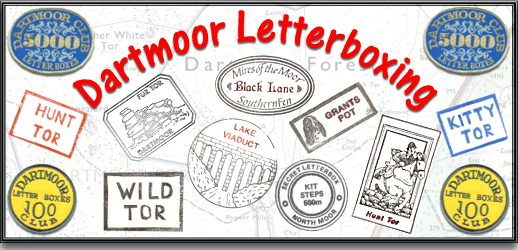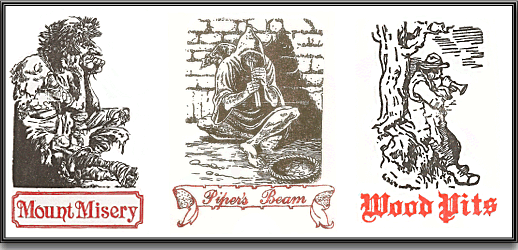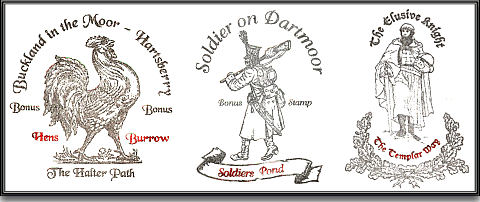
If you walk Dartmoor then sometime you are sure to encounter either a Dartmoor letterbox or Dartmoor letterboxers. The former will probably be the discovery of a small plastic pill pot hidden under a boulder and the latter will be a group of people huddled around a rock with an amazing array of cards, ink pads and pens, busily ‘stamping in’. Either way you have stumbled across the secret world of letterboxing. I do not propose to go into detail about the history and procedures of letterboxing as that is more than adequately done on numerous other sites.
As an illustration of letterboxing I will relate my letterboxing career. Many years ago whilst out for a Sunday walk in the Haytor area I came across an old ammunition can tucked under a boulder. Curiosity got the better of me and the ’Pandora’s box’ was opened to reveal a stamp, book and in those days a stamp pad. After looking through the book (visitors book) it became evident that this needed more investigation. A few weeks later armed with insider information ,cards and a pad I returned to the area and very soon had collected ten stamps. The next week I went to the ‘O’ brook area and managed to find another dozen or so. The following week I ventured out to Longaford and in the driving rain and collected some more. ‘Driving rain’ are the key words which made me realise I had been bitten by the bug because ones sanity does come into question somewhat when you find yourself trudging around the moor in such conditions searching for rubber stamps.
Over the months my obsession grew and it was not long before I sited my first box. called ‘Usig Maen Coed’. This was well hidden (or so I thought) near Wistman’s Wood and the clue was entered into ‘The 100 club’ catalogue. Things then escalated and I sited several more boxes and soon became the proud owner of my 1,000 badge. Coinciding with this I had heard about the covert world of ‘secret boxes’. This was the underworld of hard to come by clues where only the select few were privy to their whereabouts. I soon discovered that a business acquaintance was in fact very much in the know as far as these elusive clues were concerned and he agreed to take me up to Cut Hill. What an eye opener that was, the volume and quality of these stamps was amazing . Luckily I had the whole day to glean some tips of how to enter this ‘secret’ world. Basically the advice was to site some boxes and turn up at the weekly letterbox meet which in those days was held at The Welcome Stranger and then swap the clues with the other boxers. This worked well and ever since I have been siting and swapping clues.
It is strange how in life you go down one avenue and then find yourself in a situation you really weren’t expecting and this was so with my letterboxing. Thanks to this hobby I very soon developed a keen interest in the history of Dartmoor and leading on from the various excursions got to know the moor fairly well. Probably the most unexpected area letterboxing took me into was drawing. At school I did basic O’ level art and then never even drew a line for about 20 years. However designing stamps requires artwork and so I took to drawing which much to my astonishment led a few years later to the publication of my book – Pilgrimage to Dartmoor Crosses. As the years progressed my interest in the landscape, archaeology and history of the moor grew and thanks initially to letterboxing has led to formal archaeology qualifications and to me now studying for a MA degree in Landscape History/Archaeology.
Looking back over my short ‘boxing’ career I can see many changes, going from the days when clues were written in the back of visitor book and walks were manually plotted on the map with the use of a compass to the modern day boxing and the use of computer programmes to plot walks, GPS navigation to locate sites etc. Originally the actual letterbox stamps were carved out of pencil rubbers, indeed some still are today. I could never get the knack of ‘cutting’ a rubber stamp but when you see the finished work of the true masters it is amazing. Amongst the legendary cutters are such letterboxers as ‘The Pink Panthers’,’ The Dartmoor Drifter’, and sadly no longer with us ‘The Gaffer’. I will walk miles to get one of their stamps.

The above letterbox stamps are examples of the ‘master cutter’s’ craft, every one has been painstakingly carved on a pencil rubber which I think is absolutely incredible. The basic principle is to get 2 hard pencil rubbers which are about 5″ square and glue them together, these are then backed onto a piece of Perspex or wood. This is done because there are no single rubbers large enough to cut a decent design on. The design for the stamp is then ‘flipped’, scanned/photocopied and ironed onto the rubber. It is vital to ‘flip’ the image because if this is not done the stamp will appear back to front when an impression is taken. Having done this all that remains to be done is to ‘cut’ the stamp with a scalpel blade. This process involves carving out all the black areas of the design which believe me is not easy. I know for a fact that the ‘Pipers Beam’ stamp shown above took about 8 hours to make, even the lettering was cut on the rubber. Imagine a collection of letterbox stamps that are all of the above standard, I have one and it is breathtaking to look at. There is an excellent website which explains how to cut a rubber stamp called ‘Letterboxstamper’ and can be found by following the link – HERE.
The other way of producing letterbox stamps is to get them made professionally. All this entails is to draw the design, ‘flip’ it and then scan/photocopy onto a sheet which is sent to specialists that will ‘print’ the stamp on a sheet of special ‘rubber’. The cheapest way of doing this is filling an A4 sheet which will cost about £18 and normally get about 20 decent sized stamps. The sheet will have adhesive on the back so all that remains to be done is to roughly cut out the design and mount it on Perspex or wood. This is the method I use for producing letterbox stamps and below are a few of my previous stamps.

When considering a theme for your boxes PLEASE make them relevant to Dartmoor. I have seen many boxes which depict such diverse topics as Mickey Mouse etc. Well in all my years of walking I have never come across one single sighting of Mickey Mouse on Dartmoor. There is a vast scope for Dartmoor related topics and many that have not yet been used in stamp themes. I tend to do sets of stamps that will involve some basic Dartmoor research to solve the clues. For instance a few years ago the fleet of Milk Marque tankers had individual numbers and were named after Dartmoor tors. So I put stamps out on the tors and the clue consisted of bearings and the tanker number. In order to solve the clue you had to spot the tanker with that number on the road and then the name of the tor written on the side. In the end some enterprising people drove up to the tanker depot and noted down all the numbers and their corresponding tor names.
Having gone to the expense of producing a stamp PLEASE ensure that it has the place name included in it. Again I have seen many excellent stamps that are just pictures with no mention of the sites location. Some people only collect stamps with place names as they can be a reminder in years to come of a nice days walking. I can look back now to stamps I collected fifteen years ago and from the place names on the stamps I know exactly where I went and with who. Also when designing a stamp think to yourself “would you display it in your collection”? and “are you proud of it”? If the answer to either question is no then don’t waste time and money getting it made. You do not need to be Van Goch to produce nice stamps with the ready availability of photocopiers, scanners, computers, clipart and books.
Having produced your stamp you now need a ‘letterbox’ to put it in, today these are normally empty pill-pots which are the plastic pots which the chemist get their tablets in and are normally the size of a bean can and come with a sealable lid. You then will need a visitor’s book to enable other boxers to record their visit or in other words to – stamp in, for further information see; visitor’s book. Somewhere in this book, usually inside the front cover, put your contact details in case there are problems with the box, normally people just put a phone number or e mail address. Inside the visitors book it is always nice to put a blank, self-addressed and stamped postcard. This will enable the first visitor to stamp it with their personal and post the card back to you. Once you receive the card it tells you two things, firstly someone has actually found the box and secondly your clue and bearings were correct. Nearly time to get out on the moor but before going place the visitor’s book in a polythene sealable bag and then put it in a small pill-pot. Do likewise with the stamp except place this in a pot that is large enough to hold both the stamp and the pot containing the visitor’s book.
Having arrived at the place where you want to site the box find a suitable place to conceal it, then you need your compass bearings for the clue. If possible take 4 or 5 bearings around the cardinal points of the compass, most importantly use a sighting compass for accuracy. If the bearings are wrong you will soon get irate phone calls telling you so. Depending on how hard you want to make the clue chose any visible objects which could be a distant tor or a nearby fence post, the options are normally limitless. Write your chosen compass bearings down on a secure piece of paper, there is nothing worse than getting home and finding you have lost the bearings. Next jot down a brief description of the site, namely where it is and possibly what is nearby and there you have it, your box is sited.
Once you have sited a box or set of boxes you have two alternatives. Firstly you can send the clue to the Dartmoor Letterboxing 100 Club and they will enter it into the bi-annual catalogue for everybody to see. The second option is to keep the clues ‘secret’ and only give them to the people you want to have them. If you opt for the ‘secret’ option you will then be able to swap clues with other boxers who only issue ‘word of mouth clues’. If you are new to letterboxing and don’t know any ‘word of mouth’ boxers simply go along to The Dolphin at Bovey Tracey on a Wednesday night where you will met many such people. Which ever option you chose for your clues beware of one thing – eventually you WILL get a stamp stolen from its site. There are people out there who enjoy stealing stamps for whatever reason, some are visitors who accidentally find a box and don’t realise how letterboxing works and take the stamp as a memento. There are others who maliciously try to spoil other peoples enjoyment and knowingly pinch the stamps. This in some cases is done by people who think letterboxing damages the moor and should be banned and will remove every box they find. The thing to remember is don’t take it personally, yes the stamps may have taken ages to produce and cost a lot of money but apart from standing guard over the box what can you do about it? Some people will replace the missing stamp but personally I will not as it can be a never ending process. The best way to think of your letterbox stamps is as being ‘disposable’ that way if it stays on site it is a bonus if it gets taken then …
But most importantly of all don’t take it too seriously after all it is meant to be enjoyable. Every letterboxer when first starting gets bitten by the ‘numbers game’. – the need to get as many stamps as quickly as possible but gradually it will abate and you will start enjoying the walk as well.
Letterboxing is relatively cheap to do once the outdoor clothing etc has been purchased. You certainly will get plenty of exercise and meet some interesting people. But most of all you will witness many fantastic sights whilst on your walks. If you are considering taking up letterboxing and siting some of your own boxes can I give you a few personal viewpoints:
Always follow the letterboxing code. Copies can be obtained from any National Park Visitors Centre or online at: ‘Letterboxing Code’.
 Legendary Dartmoor The many aspects past and present of Dartmoor
Legendary Dartmoor The many aspects past and present of Dartmoor

Dear Tim, i really enjoyed your article i was introduced to letterboxing while on holiday on Lundy.
Although there arn’t as many letterboxes on the island people spend quite a lot of time looking for them.
Some of these boxes are quite hard to get to when you are a bit older and not as good on your legs, but it is quite amusing to see grown men and women climbing over rocks to find them.
Some of the Lundy boxes get changed and different cachets are placed in them.
Some of the earlier boxes used to appear on Ebay where they seemed to be quite sort after.
Best wishes with your hobby.
Graham Chadwick.
Hello.This article was extremely fascinating, especially because I was searching for thoughts on this topic last Friday.
Not a comment, a question really. You say “The cheapest way of doing this is filling an A4 sheet which will cost about £18 and normally get about 20 decent sized stamps.”
where do you get this done?
Fantastic designs!